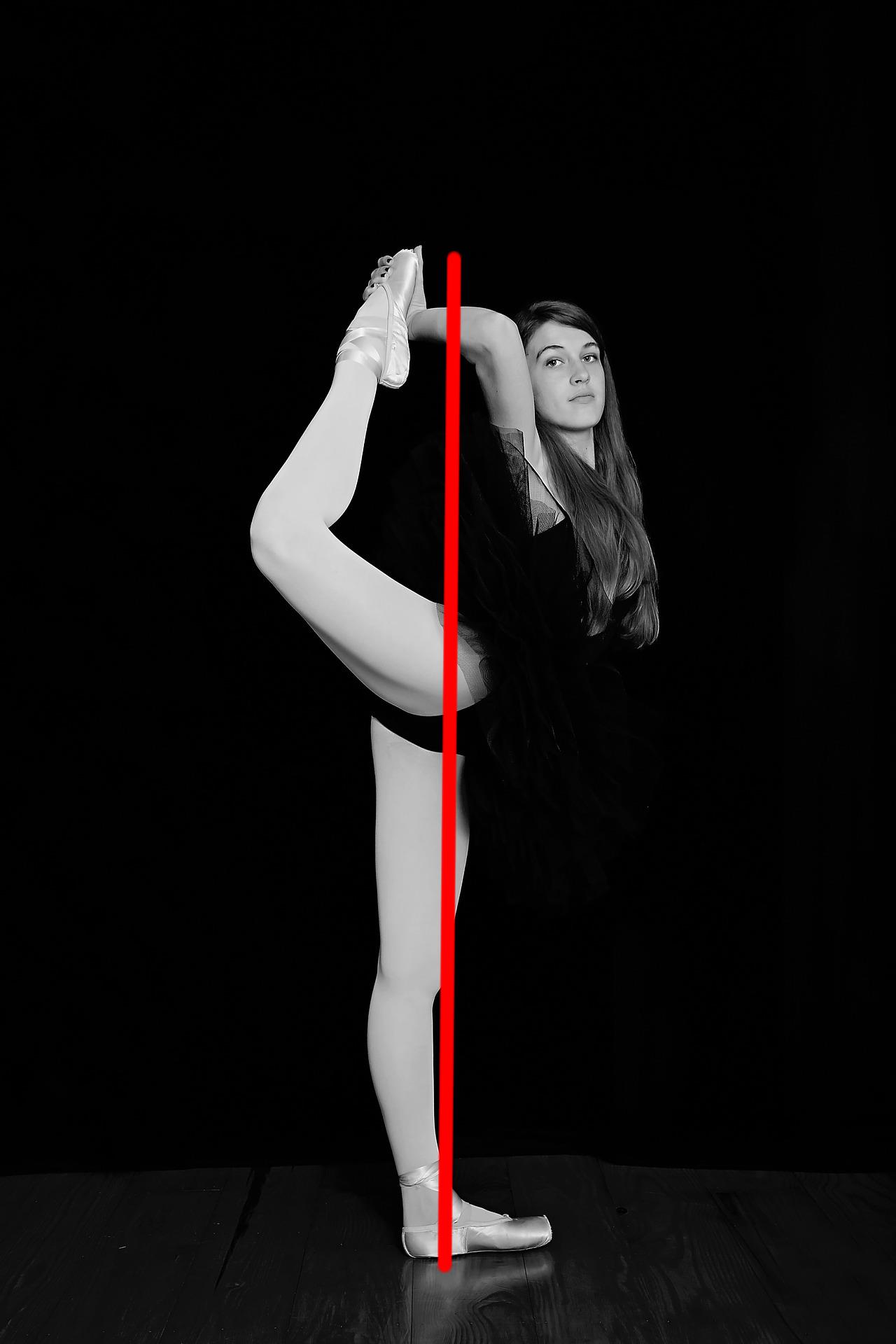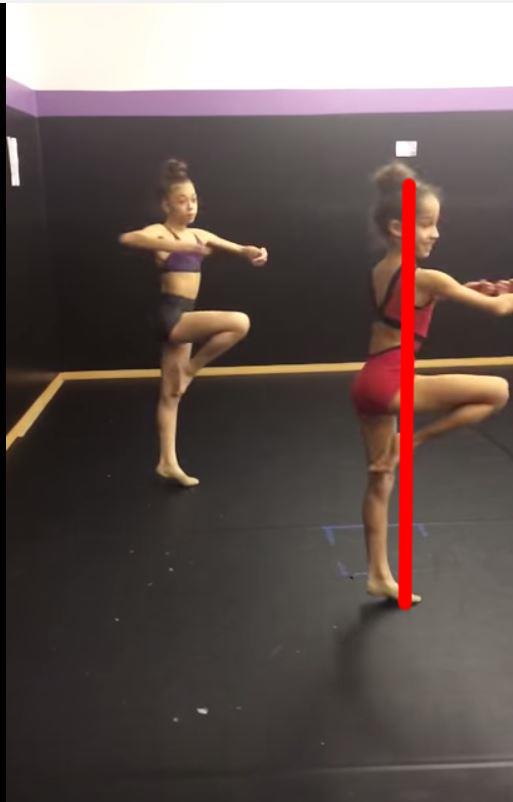
Improve Your Turns by Understanding the Plumb Line
You probably think of yourself as either a “turner” or a “leaper.” Leapers: You can fly through the air with beautiful split leaps and cool tricks, but you can’t do a double pirouette to save your life. Turners: you could do fouettés and pirouettes all day, but your leaps look like a limp fish. If you’re a turner, I suggest you check out my post on how to improve your leaps. Leapers, stay here to learn how to improve your turns.
The Plumb Line

A lot of dance teachers (and sculptors, painters, etc.) talk about the plumb line of the body. But what the heck is a plumb line? It’s a simple concept that has been used since ancient times. All you have to do is attach a string to a weight (the “plumb bob”), and let it hang down. From your hand to the weight will be a straight vertical line. Ancient builders used them to make sure their buildings were straight.
Now, obviously your body doesn’t actually have one of those, but because of how gravity works, your body (when it’s on-balance) will always be centered around a straight line, your “plumb line.”
Example of the plumb line in dance

Notice how the red line bisects this young woman’s pose. Half of her weight is on one side and half is on the other side. In other words, the arch of her back matches the arch of her working leg, and the standing leg is right in the middle.
Now you might be thinking about poses like al a seconde, where one leg sticks out to the side with nothing to counterbalance it on the other side. How do people balance like that? I’ll use an analogy to explain.
Imagine trying to balance a Barbie doll in al a seconde. It would never work, no matter how hard you tried. Even if your Barbie had perfect ballet technique and feet that could actually stand on their own (something that always frustrated me about those dolls), the weight of her working leg would pull her over. That’s the idea of plumb line and counterbalance in action. Any pose you can actually balance your Barbie in (good luck) will be a perfect distribution of her weight across the plumb line. Al a seconde is not.
Add the human factor to the equation, and there’s so much more you can do, because you have muscles. You balance in al a seconde by countering the weight of the working leg with energy on the standing side. Your core, rotators, and even your calf and ankle are using energy to maintain their shape. It’s a workout. Sometimes balance feels easy, other times you have to hold it.
So that’s your plumb line. Now how can you use it to improve your turns?
Visualize your plumb line in pirouette position
This may surprise you, but balancing in passé shouldn’t require that much effort. Learning this revolutionized the way I balanced and turned. Your teacher might be telling you to hold your core, squeeze your rotators, press the shoulders down, push into the floor, lift out of the floor, all those things that dance teachers say, and you’re thinking, “How am I supposed to think of all these things at once?” Those things are not necessary for balance. Am I saying to forget about your technique? Of course not! I’m saying that technique and balance are two different things.
Try this: stand on one leg on relevé, no turnout, no pointing the other foot, no arms. Just hang out there on one leg. It might still be difficult, but with a little practice, you’ll soon see that with no technique at all, you can balance for 10-15 seconds easily.
While you’re balancing, think of where your plumb line is. It starts at the top of your head, goes through the middle of your body, past the sits bone, into the thigh, through the knee, into the ankle, and finally to where your foot meets the floor. Try to add some technique while maintaining this plumb line: turn out a bit (don’t force it), point the working foot, add some arms. Do this all the time so your body memorizes what balance feels like.
From balancing to turning
Have you ever had a teacher say, “If you can balance for four counts, you should be able to do four pirouettes”? Haha, if only it were that easy. While balancing should require very little effort once you’re on, turning is another story. Technically, yes, a pirouette is just maintaining your balance while you spin on one foot, but it’s way harder to balance while you’re spinning than when you’re standing still. You have a lot of force acting on you during a turn, so you have to hold your shape tight or you’ll fall off.
There are only two reasons pirouettes fail. 1) You weren’t on balance to begin with, and 2) You lost your balance during the turn. Number 1 is the culprit 90% of the time. If you’re on your leg when you start turning, you’re good until you run out of momentum as long as you can hold your shape. That’s why a top can spin like crazy but a rag doll can’t. A rag doll can’t hold her shape.
Check out this video for an example of the plumb line in a pirouette:
Did you notice what I noticed? (If so, you should be a dance teacher.) Both kids achieve nice clean triples, but their technique is flawed. Their relevés are low and they are leaning forward. How do they have flawed technique but still manage to do a triple pirouette? The answer is in the plumb line.

What would happen if this girl kept her overall shape but had a higher relevé? She would fall forward. Likewise, what would happen if she put her shoulders over her hips but kept her low relevé? She would fall backward. Even though her technique is flawed, she can still turn because she’s balanced around a plumb line!
This reiterates what I said before: technique and balance are different things. These girls have good balance; they can easily do a triple pirouette. But they still have technical issues to fix. I highly recommend taking a similar video of yourself. Pause the video to see yourself at different angles and check your plumb line. Do this even if you’re getting consistent triples and quadruples. Just because you can turn doesn’t mean you have perfect technique!
Takeaways
- If your body weight isn’t centered around the point of contact with the floor (the ball of your foot), you won’t be on balance.
- Balance and technique are two different things.
- Practicing your balance, even without technique, will help your body learn where the plumb line is and improve your turns.
- There are only two reasons pirouettes fail: You weren’t on your leg to begin with or you lost your balance during the turn.
- Take a video of yourself to check your plumb line in your turns.
Did this help improve your turns? What are your favorite tips and tricks for turning? Let me know in the comments!
Related post: How to Improve Your Leaps with Simple Physics






